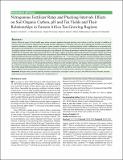| dc.contributor.author | Ombori, Robert O. | |
| dc.contributor.author | Owuor, P. Okinda | |
| dc.contributor.author | Kamau, David M. | |
| dc.contributor.author | Kwach, Bowa O. | |
| dc.contributor.author | Dufitumukiza, Wilson | |
| dc.contributor.author | Msomba, Solomon W. | |
| dc.date.accessioned | 2021-01-19T20:26:03Z | |
| dc.date.available | 2021-01-19T20:26:03Z | |
| dc.date.issued | 2020 | |
| dc.identifier.issn | DOI: 10.20425/ijts1513 | |
| dc.identifier.uri | https://repository.maseno.ac.ke/handle/123456789/3589 | |
| dc.description.abstract | Eastern Africa tea grows in high rainfall areas where nutrients depletion through leaching, and surface run-off can be high, in addition to removal with crop. Nutrients replenishment through fertilizer applications is therefore necessary. But inappropriate fertilizer use can cause nutrients imbalance, change soil pH, and organic carbon contents. Variations in plucking intervals result in differences in tea productivity. Although environmental factors vary within Eastern Africa tea growing regions, recommended fertilizer type and rates and harvesting intervals are largely uniform. Fertilizer use and harvesting policy may influence soil chemical parameters within the region to varying degrees. Effects of NPKS 25:5:5:5 fertilizer rates and plucking intervals on soil organic carbon, pH and the relationship between soil organic carbon, pH and tea yields in Eastern Africa were evaluated. Trials were conducted on clone TRFK 6/8 at Timbilil, Changoi, Arroket (Kenya), Maruku, Katoke (Tanzania), Kitabi and Mulindi (Rwanda). Soil organic carbon contents ranged from 4.16 – 17.61% and were sufficient. Increasing nitrogen rates increased (p ≤ 0.05) soil organic carbon but lowered (p ≤ 0.05) soil pH. The pH values ranged between 3.22 and 4.84. The increase in soil acidity due to high rates of nitrogen rates reduce tea productivity in the long run. Periodic monitoring of soil pH is necessary in tea production to invoke mitigation
activities when decline below 3.5. Plucking intervals had no influence on SOC and pH at all sites. Soil organic carbon and pH varied significantly (p ≤ 0.05) from location to location, though the values were within acceptable range. Soil organic carbon directly correlated (r.>0.878; p ≤ 0.05 for all sites except Mulindi and Maruku) with yields and inversely (r≤-0.878, p≤0.05 for most sites) with pH. The correlation between SOC and
yields suggest that tea production management need to maintain SOC at optimal levels realization of sustained tea yields. | en_US |
| dc.description.sponsorship | The National Commission for Science, Technology (Kenya) and
Innovation and Inter-University Council of East Africa (VicRes | en_US |
| dc.language.iso | en | en_US |
| dc.publisher | International Society of Tea Science | en_US |
| dc.relation.ispartofseries | ;DOI: 10.20425/ijts1513 | |
| dc.subject | Nitrogen rates; plucking intervals; location of production; soil organic carbon; soil pH; Clone TRFK 6/8; Kenya; Rwanda; Tanzania | en_US |
| dc.title | Nitrogenous Fertilizer Rates and Plucking Intervals Effects on Soil Organic Carbon, pH and Tea Yields and Their Relationships in Eastern Africa Tea Growing Regions | en_US |
| dc.type | Article | en_US |

